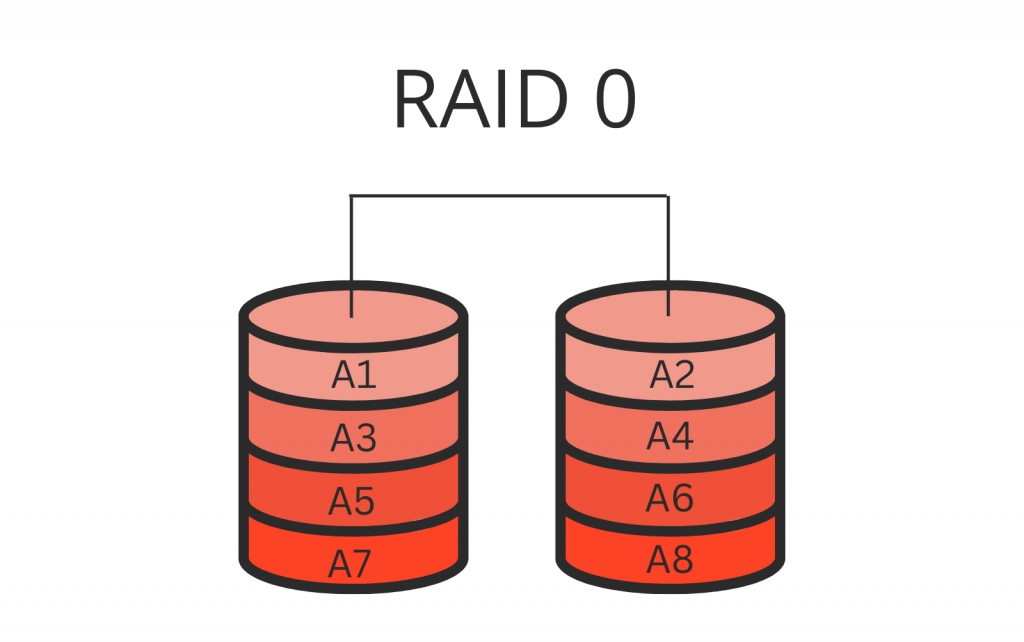Invention & History
- Introduced: 1987
- Invented by: David A. Patterson, Garth Gibson, and Randy H. Katz at the University of California, Berkeley
- Origin: In their influential paper “A Case for Redundant Arrays of Inexpensive Disks (RAID)”, RAID 0 was proposed as one of several RAID levels. Ironically, RAID 0 offers no redundancy, even though “RAID” stands for Redundant Array of Inexpensive Disks.
How RAID 0 Works
- Data striping: RAID 0 splits (stripes) data evenly across two or more disks.
- There is no duplication of data or parity.
- It improves performance by parallelizing read/write operations.
Example:
Let’s say you want to write the word LINUX across 2 disks:
- Disk 1 gets: L, N, X
- Disk 2 gets: I, U
Both disks operate simultaneously, increasing throughput.

In this image we can see that there are 2 Disks and data is split (striped) evenly across both the disks.
Features
| Feature | Value |
|---|---|
| Minimum Disks | 2 |
| Redundancy | ❌ No redundancy |
| Fault Tolerance | ❌ None — failure of one disk = total data loss |
| Performance | ✅ Excellent read/write speed |
| Capacity | ✅ 100% usable (sum of all disk space) |
| Suitable for OS Boot? | ✅ Yes (if you can recover from failure quickly) |
Advantages
- High performance: Especially for large file transfers and random reads/writes.
- Full disk usage: No storage overhead for parity or mirroring.
- Simple setup: Easy to implement and configure.
- Cost-effective performance boost: Ideal for non-critical high-speed storage.
Disadvantages
- No fault tolerance: If one disk fails, all data is lost.
- Not ideal for critical data unless backed up separately.
- No data recovery mechanism: Unlike RAID 5 or RAID 10.
Common Use Cases
- Video editing / 3D rendering
- Scratch disks / temporary data
- Gaming PCs
- Cache or non-critical data storage
- Fast but volatile virtual machine storage
Operating System Support
| Operating System | Support RAID 0? | Notes |
|---|---|---|
| Linux | ✅ Yes (via mdadm) | Software RAID setup |
| Windows | ✅ Yes (via Disk Management or Storage Spaces) | Called a “Striped Volume” |
| macOS | ✅ Yes (via Disk Utility or diskutil) |
Hardware RAID Support
- Supported by nearly all modern RAID controllers (e.g., Dell PERC, HP SmartArray, LSI MegaRAID)
- Often configurable via BIOS/UEFI or hardware RAID utility
When Not to Use RAID 0
- When data loss is unacceptable
- For production databases
- On critical servers
- Without frequent backups
Conclusion
RAID 0 is the fastest and simplest RAID level in terms of performance and setup. By striping data across multiple disks without any redundancy, RAID 0 offers maximum read and write speed, making it ideal for scenarios where performance is critical and data loss is not a concern. It fully utilizes the combined storage of all disks, with no overhead for parity or mirroring.
However, the absence of fault tolerance is its biggest drawback. If even one disk fails, all data in the RAID 0 array is lost, making it unsuitable for any system that stores important or irreplaceable information.
RAID 0 is best used in scenarios where:
- Performance is more important than reliability
- Data is non-critical or easily recoverable
- Frequent backups are maintained externally
In summary, RAID 0 is great when you need raw speed and can afford to lose the data, but it’s never a good choice for systems where reliability or data integrity is important. Use it with caution — and always pair it with external backup solutions if the data matters.